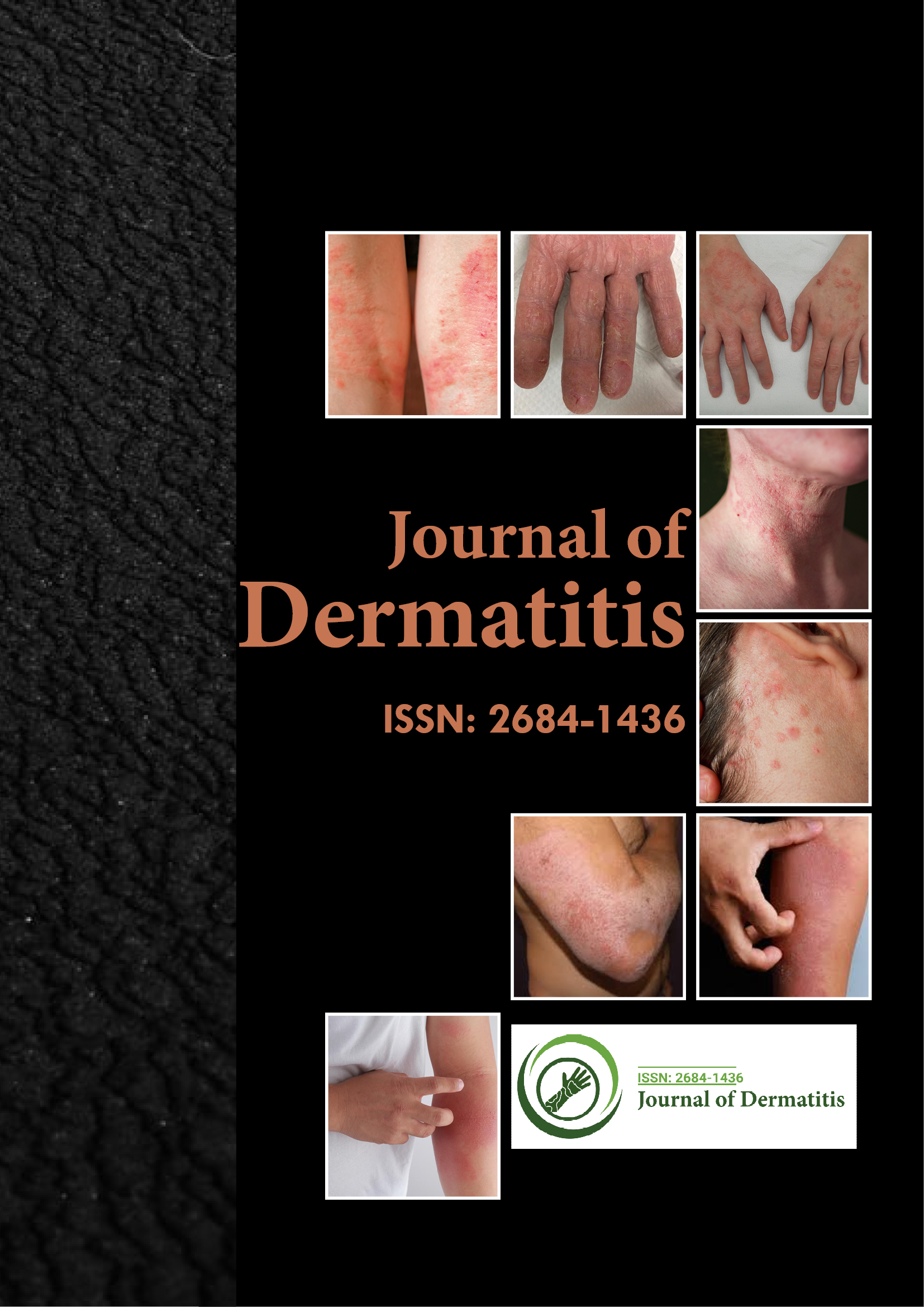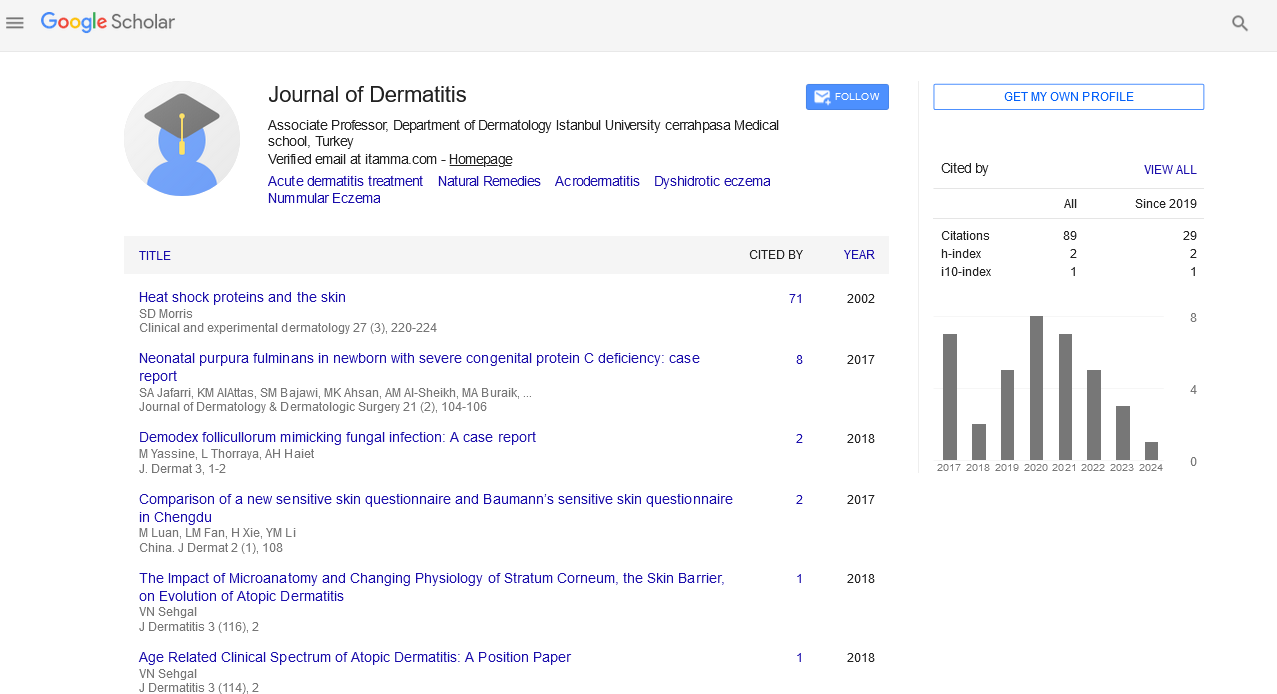Indexed In
- RefSeek
- Hamdard University
- EBSCO A-Z
- Euro Pub
- Google Scholar
Useful Links
Share This Page
Journal Flyer

Open Access Journals
- Agri and Aquaculture
- Biochemistry
- Bioinformatics & Systems Biology
- Business & Management
- Chemistry
- Clinical Sciences
- Engineering
- Food & Nutrition
- General Science
- Genetics & Molecular Biology
- Immunology & Microbiology
- Medical Sciences
- Neuroscience & Psychology
- Nursing & Health Care
- Pharmaceutical Sciences
Short Communication - (2023) Volume 8, Issue 1
Fundamental Examination of Bacterial Skin Ailments Causes and its Medication
Hung Jhu*Received: 02-Jan-2023, Manuscript No. JOD-23-20687; Editor assigned: 04-Jan-2023, Pre QC No. JOD-23-20687 (PQ); Reviewed: 18-Jan-2023, QC No. JOD-23-20687; Revised: 25-Jan-2023, Manuscript No. JOD-23-20687 (R); Published: 01-Feb-2023, DOI: 10.35248/2684-1436.23.08.181
Description
Bacterial skin infections are a common problem that affects people of all ages and demographics. They are caused by a variety of bacteria and can present in various forms, ranging from mild to severe. This article will explore the causes, symptoms, and treatments of bacterial skin infections. The first line of defence is the skin, which acts as a physical barrier against microbial invasion, healthy microbiome, low pH and temperature, abundant of antimicrobial peptides, and abundance of antimicrobial peptides. Skin infections can, however, emerge when the barrier that protects the skin is compromised, damaged, or suffers from a microbial dysbiosis. Infections of the skin and soft tissues are most commonly brought on by Staphylococcus aureus in the United States of America [1-3].
Causes of bacterial skin infections
Bacterial skin infections can be caused by several types of bacteria, including Staphylococcus aureus, Streptococcus pyogenes, and Pseudomonas aeruginosa. These bacteria can enter the skin through a cut or wound, or they can invade the skin through a hair follicle. Several factors increase the risk of developing a bacterial skin infection, including poor hygiene, weakened immune system, obesity, and chronic skin conditions such as eczema and psoriasis. Additionally, certain professions, such as healthcare workers and athletes, may be at a higher risk due to increased exposure to bacteria [4-6].
Symptoms of bacterial skin infections
The symptoms of a bacterial skin infection vary depending on the type and severity of the infection.
Some common symptoms include:
• Warmth, swelling, and redness surrounding the afflicted area
• Pain or tenderness
• Pus or other effluent from the site
• Fever
• Rash or blisters
In severe cases, a bacterial skin infection can lead to cellulitis, an infection of the skin and underlying tissue. Symptoms of cellulitis include redness, swelling, warmth, and tenderness, as well as fever, chills, and fatigue [7,8].
Treatment of bacterial skin infections
The treatment of a bacterial skin infection depends on the severity of the infection and the type of bacteria causing it. Mild infections can often be treated with topical antibiotics, such as mupirocin or bacitracin. These medications are applied directly to the affected area and help to kill the bacteria causing the infection. For more severe infections, oral or intravenous antibiotics may be necessary. It is essential to complete the antibiotic course even if symptoms go away before the prescribed amount of time has passed. Antibiotic-resistant bacteria may emerge if the entire course of antibiotics is not taken. In addition to antibiotic treatment, it is important to practice good hygiene to prevent the spread of bacterial skin infections. This includes washing hands frequently, keeping cuts and wounds clean and covered, and avoiding sharing personal items such as towels and razors [9,10].
Conclusion
Bacterial skin infections are a common problem that can range from mild to severe. They are caused by a variety of bacteria and can present with a range of symptoms, including redness, swelling, and pain. Treatment typically involves antibiotics, and it is important to complete the full course of medication to prevent the development of antibiotic-resistant bacteria. Practicing good hygiene is also important in preventing the spread of bacterial skin infections. If patient suspect have a bacterial skin infection, contact healthcare provider for proper diagnosis and treatment.
References
- Cabanillas B, Novak N. Atopic dermatitis and filaggrin. Curr Opin Immunol. 2016;42:1-8.
[Crossref] [Google Scholar] [PubMed]
- De Benedetto A, Rafaels NM, McGirt LY, Ivanov AI, Georas SN, Cheadle C, et al. Tight junction defects in patients with atopic dermatitis. J Allergy Clin Immunol. 2011;127(3):773-786.
[Crossref] [Google Scholar] [PubMed]
- Katoh N, Ohya Y, Ikeda M, Ebihara T, Katayama I, Saeki H, et al. Japanese guidelines for atopic dermatitis 2020. Allergol Int. 2020;69(3):356-369.
[Crossref] [Google Scholar] [PubMed]
- Schempp CM, Windeck T, Hezel S, Simon JC. Topical treatment of atopic dermatitis with St. John's wort cream–a randomized, placebo controlled, double blind half-side comparison. Phytomedicine. 2003;10:31-7.
[Crossref] [Google Scholar] [PubMed]
- Ellison JA, Patel L, Ray DW, David PT, Clayton PE. Hypothalamic-pituitary-adrenal function and glucocorticoid sensitivity in atopic dermatitis. Pediatrics. 2000;105(4):794-799.
[Crossref] [Google Scholar] [PubMed]
- De Vries HJ, Schallig HD. Cutaneous Leishmaniasis: A 2022 Updated Narrative Review into Diagnosis and Management Developments. Am J Clin Dermatol. 2022;23(6):823-840.
[Crossref] [Google Scholar] [PubMed]
- Weina PJ, Neafie RC, Wortmann G, Polhemus M, Aronson NE, Strausbaugh LJ. Old world leishmaniasis: an emerging infection among deployed US military and civilian workers. Clin Infect Dis. 2004;39(11):1674-1680.
[Crossref] [Google Scholar] [PubMed]
- Aronson N, Herwaldt BL, Libman M, Pearson R, Lopez-Velez R, Weina P, et al. Diagnosis and treatment of leishmaniasis: clinical practice guidelines by the Infectious Diseases Society of America (IDSA) and the American Society of Tropical Medicine and Hygiene (ASTMH). Clin Infect Dis. 2016;63(12):202-264.
[Crossref] [Google Scholar] [PubMed]
- Murray HW. Leishmaniasis in the United States: treatment in 2012. Am J Trop Med. 2012;86(3):434.
[Crossref] [Google Scholar] [PubMed]
- Ramalho DB, Silva RE, Senna MC, Moreira HS, Pedras MJ, Avelar DM, et al. Meglumine antimoniate intralesional infiltration for localised cutaneous leishmaniasis: a single arm, open label, phase II clinical trial. Mem Inst Oswaldo Cruz. 2018;113.
[Crossref] [Google Scholar] [PubMed]
Citation: Jhu H (2023)Fundamental Examination of Bacterial Skin Ailments Causes and its Medication. J Dermatitis.8:181.
Copyright: © 2023 Jhu H. This is an open-access article distributed under the terms of the Creative Commons Attribution License, which permits unrestricted use, distribution, and reproduction in any medium, provided the original author and source are credited.

